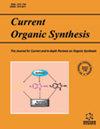以盐酸咪唑为促进剂,从邻氨基苯甲酸和 DMF 衍生物中单锅合成 2,3-二取代-4(3H)-喹唑啉酮。
IF 2.5
4区 化学
Q3 CHEMISTRY, ORGANIC
引用次数: 0
摘要
盐酸咪唑作为一种新型环保的勃氏酸,被用来促进邻氨基苯甲酸和 DMF 衍生物合成 2,3-二取代-4(3H)-喹唑啉酮。该反应的本质是一种多组分反应,通过盐酸咪唑的反酰胺化作用在不同组分之间构建多个化学键。该方案显示了广泛的官能团容限,在不使用金属催化剂、氧化剂或其他添加剂的情况下,以低至中等产率合成了一系列喹唑啉酮。本文章由计算机程序翻译,如有差异,请以英文原文为准。
One-pot Synthesis of 2,3-disubstituted-4(3H)-quinazolinone from o-aminobenzoic Acid and DMF Derivatives using Imidazole Hydrochloride as a Promoter.
As a novel and environmentally friendly Brönsted acid, imidazole hydrochloride was used to promote the synthesis of 2,3-disubstituted-4(3H)-quinazolinone from o-aminobenzoic acid and DMF derivatives. The essence of this reaction is a multicomponent reaction, which constructs multiple chemical bonds between different components through the transamidation of imidazole hydrochloride. This protocol showed a wide range of functional group tolerance, and a series of quinazolinones were synthesized in low to moderate yields without metal catalysts, oxidants or other additives.
求助全文
通过发布文献求助,成功后即可免费获取论文全文。
去求助
来源期刊

Current organic synthesis
化学-有机化学
CiteScore
3.40
自引率
5.60%
发文量
86
审稿时长
6-12 weeks
期刊介绍:
Current Organic Synthesis publishes in-depth reviews, original research articles and letter/short communications on all areas of synthetic organic chemistry i.e. asymmetric synthesis, organometallic chemistry, novel synthetic approaches to complex organic molecules, carbohydrates, polymers, protein chemistry, DNA chemistry, supramolecular chemistry, molecular recognition and new synthetic methods in organic chemistry. The frontier reviews provide the current state of knowledge in these fields and are written by experts who are internationally known for their eminent research contributions. The journal is essential reading to all synthetic organic chemists. Current Organic Synthesis should prove to be of great interest to synthetic chemists in academia and industry who wish to keep abreast with recent developments in key fields of organic synthesis.
 求助内容:
求助内容: 应助结果提醒方式:
应助结果提醒方式:


